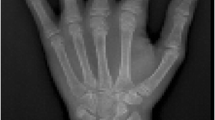Abstract
Hinman syndrome was a non-neurogenic neurogenic bladder and the most severe form of dysfunctional voiding disorder. The bladder–sphincter discoordination causes damage to the bladder and upper urinary tract if it is not diagnosed early and treated adequately. This case emphasizes the following important message: nighttime wetting is not a benign condition in every child. Parental awareness should be raised about voiding disorders, as it may be possible to prevent important renal diseases such as Hinman syndrome.

Similar content being viewed by others
References
Hinman F, Bauman FW (1973) Vesical and ureteral damage from voiding dysfunction in boys without neurologic or obstructive disease. J Urol 109:727–732
Rashid S, Waqar M, Khawaja AA, Arshad MS, Sarwar MK (2011) Efficacy of transcutaneous nerve stimulation (TENS) therapy in overactive non-neurogenic neurogenic bladder (Hinman’s syndrome). Pak J Med Sci 27:528–532
Allen TD (2003) Forty years’ experience with voiding dysfunction. BJU Int 92:15–22
McGuire EJ, Savastano JA (1984) Urodynamic studies in enuresis and the nonneurogenic neurogenic bladder. J Urol 132:299–302
Combs AJ, Van Batavia JP, Chan J, Glassberg KI (2013) Dysfunctional elimination syndromes—how closely linked are constipation and encopresis with specific lower urinary tract conditions? J Urol 190:1015–1020
Austin PF, Bauer SB, Bower WF, Chase J, Franco I, Hoebeke P, Rittig S, Vande Walle J, von Gontard A, Wright A, Yang SS, Nevéus T (2014) The standardization of terminology of lower urinary tract function in children and adolescents: update for the standardization Committee of the International Children’s continence society. J Urol 191:1863–1865
Al Mosawi AJ (2007) Identification of nonneurogenic neurogenic bladder in infants. Urology 70:355–356
Aydogdu O, Burgu B, Demirel F, Soygur T, Ozcakar ZB, Yalcinkaya F, Tekgul S (2010) Ochoa syndrome: a spectrum of urofacial syndrome. Eur J Pediatr 169:431–435
Ochoa B (2004) Can a congenital dysfunctional bladder be diagnosed from a smile? The Ochoa syndrome updated. Pediatr Nephrol 19:6–12
Woolf AS, Stuart HM, Newman WG (2014) Genetics of human congenital urinary bladder disease. Pediatr Nephrol 29:353–360
Woolf AS, Stuart HM, Roberts NA, McKenzie EA, Hilton EN, Newman WG (2014) Urofacial syndrome: a genetic and congenital disease of aberrant urinary bladder innervation. Pediatr Nephrol 29:513–518
Smith C, Chanchellor M (2004) Emerging role of botulinum toxin in the management of voiding dysfunction. J Urol 171:2128–2137
Author information
Authors and Affiliations
Corresponding author
Ethics declarations
Conflicts of interest
None to declare.
Declaration
All information for this report was gathered retrospectively. For this type of study, formal consent by an ethics committee is not required. We did obtain informed consent from our patient before publication.
Additional information
This refers to the article that can be found at doi: 10.1007/s00467–017–3691-7.
Rights and permissions
About this article
Cite this article
Yılmaz, A.Ç., Buyukkaragoz, B., Kivilcim, S. et al. An adolescent boy progressing insidiously to end-stage renal disease: Answers. Pediatr Nephrol 33, 429–431 (2018). https://doi.org/10.1007/s00467-017-3700-x
Received:
Revised:
Accepted:
Published:
Issue Date:
DOI: https://doi.org/10.1007/s00467-017-3700-x




